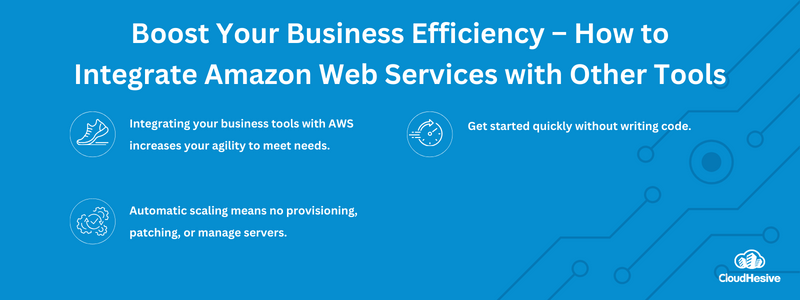Improve collaboration, communication, and get ready to grow

The speed of business today requires a cloud partner that’s reliable, easy to use, flexible, cost-effective, scalable, fast, and easy integrate. With Amazon Web Services (AWS), you get all that and more to increase agility.
Application integration on AWS is a set of services that enables the secure transfer of data between SaaS applications you’re already using – such as Salesforce, Marketo, and Slack. It’s made easy with pre-built connectors, or you can do custom integration.
In this article, we’ll discuss how to integrate AWS with other tools, the benefits of integration, choosing the right integration method, best practices, and some step-by-step instructions.
About Amazon Web Services
AWS is the most widely used cloud in the world. It offers 200 full-featured services from data centers around the globe. That’s because it offers everything you want in a cloud provider: user-friendly, flexible, secure, cost-effective, reliable, scalable, elastic, and high performing.
The key components of AWS include
- Data management and transfer
- Computing and networking
- Storage
- Automation and orchestration
- Operations and management
- Visualization tools
- Security and compliance
This broad range of infrastructure services allows you to choose what you need to make your business run efficiently, by selecting the best mix of resources for specific applications. AWS offers three types of cloud computing:
- Infrastructure as a service (IaaS) has the basic building blocks for cloud IT, offering access to networking features and data storage space. This gives you the most flexibility and management control over resources, paralleling the in-house server management.
- Platform as a service (PaaS) removes the need to manage underlying infrastructure for increased efficiency – no more worries about resource procurement, capacity planning, patching, and maintenance, leaving the heavy lifting to AWS.
- Software as a service (SaaS) offers a complete product run and is managed by AWS, so instead of worrying about infrastructure management, you only must think about how you’ll use a particular piece of software.
The benefits of integrating AWS with other tools
AWS makes integrating distributed systems and SaaS applications with less code easy, enabling communication between decoupled components. When you integrate applications, you shift operational responsibilities to AWS, and with automatic scaling, you never need to provision, patch, and manage servers.
Your business can operate more efficiently by having everything in one place – AWS. You gain advanced functionality, improve collaboration, and save money. Plus AppFlow makes it easy since it’s a fully managed integration service that securely transfers data between SaaS applications and AWS services in just a few clicks, running data flows at enterprise scale at your chosen frequency.
Using AppFlow to integrate your business tools
With Amazon Appflow, you can get started quickly without writing code, as well as do the following:
- Keep data in sync by running flows on demand or a schedule
- Aggregate data from multiple sources
- Management tools to monitor data moved – what, where, and when
- Keep data secure – AppFlow encrypts data at rest and in transit
Now let’s look at how to integrate Amazon Web Services with other tools
Start using AppFlow with these simple steps
1. Name your flow, and add an intuitive description
2. Connect your data source and integration. Choose from the integrated application sources and destinations and enter your credentials.
3. Choose a data flow trigger:
a. On-demand flows run immediately once.
b. Scheduled flows run at specific intervals that you set
c. Event-based flows run in response to business events you specify
4. Map source fields to their destination. Configure field mapping, or if you have a large dataset with many fields, you can upload a csv file with bulk field mappings. You can also add data field transformations, such as masking sensitive information.
5. Optional – add data filters and validations.
6. Click Create Flow, and your data will flow based on your triggers.
Best practices for integrating AWS with other tools
Before integrating business tools with AWS, it’s essential to understand your business needs. Do you have apps you are no longer using? Or apps that are at end-of-life? Think of your business perspective first, then the technical aspects. Then you can:
- Take a step-by-step approach
- If you have older apps, check for compatibility
- Configure your apps properly
- Establish security protocols to protect sensitive in-app data
- Monitor the performance of your apps – are they doing what you need, or is there a better choice?
- Plan for future scalability – will your apps handle your growth goals?
Integrating your business tools with AWS streamlines workflows and improves productivity, enhances collaboration and communication, improves data accuracy with access to the most up-to-date information, and offers scalability and flexibility for your business ecosystem.
From a complete migration to business tool integration, CloudHesive can help. We’re a cloud solutions consulting and managed service provider with expertise in Amazon Web Services. We have eight AWS Competencies, more than 50 AWS Certifications, and membership in nine Partner Programs. We use our knowledge and experience to equip your business to realize all the benefits of AWS and associated services.
We can help you, just like we’ve helped more than 100 companies reduce operating costs and increase productivity with a focus on security, reliability, availability, and scalability. We have more than 30 years of experience and leverage cloud-based technology to its full potential. Contact the CloudHesive team today.



